Showroom Paris
travelling through 498 years of fashion history
in a unique hotspot
Showroom
"Pavillon des Drapiers"
long before "Showroom Paris"

photo editing of two different buildings
on 11 rue des Déchargeurs
Showroom Paris has a fascinante fashion history
that goes back in time
1188 is the year where can be found
the first written documents about the drapers.
Drapers were fabric professionals
for making clothes.
.
1527 the drapers settled on
13 rue des Déchargeurs
on a site that is now located
between
the roadway of Rue des Halles
(built in 1868)
and the terrace of the Bistrot des Halles.
.
Opening of the Pavillion
Le Pavillon des Drapiers

1648 The Drapiers
purchased
the building next door
at 11 rue des Déchargeurs.
Work on the Pavillion des Drapiers began
under supervision of architect Jacques Bruant (1624-1664),
older brother of the architect Liberal Bruant (1636-1697)
who designed Les Invalides.
child Louis XIV
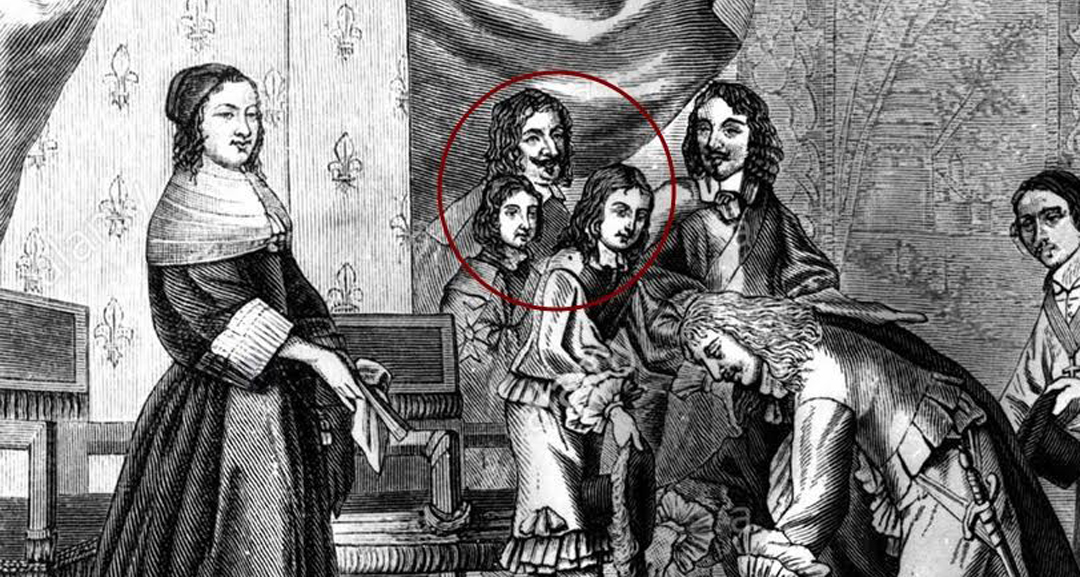
A young child watched the construction of the Pavilion
because the house next door,
9 rue des Déchargeurs,
the Hôtel de Villeroy Bourbon / VB
was
the home of his teacher, Nicolas V de Villeroy (1598-1685).
The child was the young Sun King, Louis XIV.
.

The Drapiers' Pavilion, completed in 1660,
has a fascinating fashion history.
The Drapiers' Pavilion was where fashion professionals gathered
to defend their interests before the Bourbons, Kings of France.
Much of this history has been lost,
but from time to time - thanks to the internet - forgotten stories resurface.
.

1671 Nicolas V de Villeroy sells the Hotel de Villeroy
as Louis XIV had invited his childen to stay in the Palace of Versailles.
He moves to Saint Germain en Laye.
The Hotel de Villeroy, also called VB
for Villeroy Bourbon
becomes the seat of Postal company,
ancester of the Phone Book of the World.
.
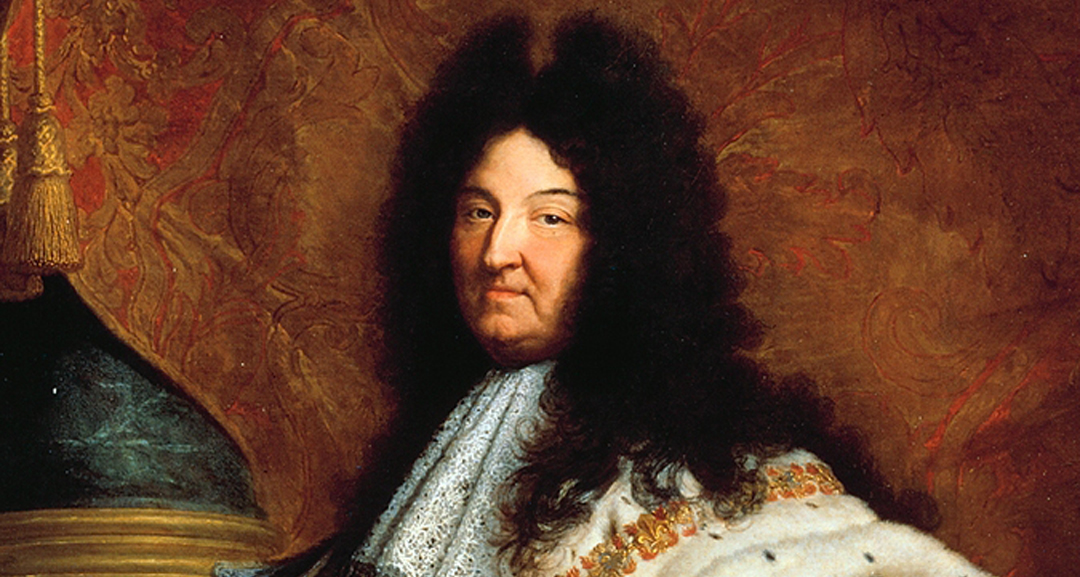
1700s Louis XIV continued
to visit Rue des Déchargeurs
throughout his life
because he maintained ties
with the Hôtel de Villeroy Bourbon (VB).
His teacher's house
now the home and company seat of
Postmaster
Louis Leon Pajot (1678-1754)
a confidant of the King.
Anslem Franz von Thurn & Taxis is another
Postmaster linked to the story of the house.
.
1738 While the Pavillon des Drapiers
continues it's fashion activities,
the postal activities
of the next door VB mansion
(other part of the showroom) come to an end
upon a decision of the 4th Bourbon King, Louis XV.
End of a Technology story
that will return in 1986

This picture shows the VB gate,
the left side of Showroom N°1
and the old postmasters
Louis Leon Pajot
and Anselm Franz Thurn & Taxis
Today Anselm Franz Thurn & Taxis
is part of the logos of the Whitepages
of over 50 countries edited
trom the VB mansion.

Whitepages.pl
features the PFW showroom
for the iconic Polish brand
Misbhv
that came to Showroom N°1 in 2020
.
Marie Antoinette

map of rue des Déchargeurs from 1780
The N° in white correspond
to todays Showroom locations
and their Cafes.
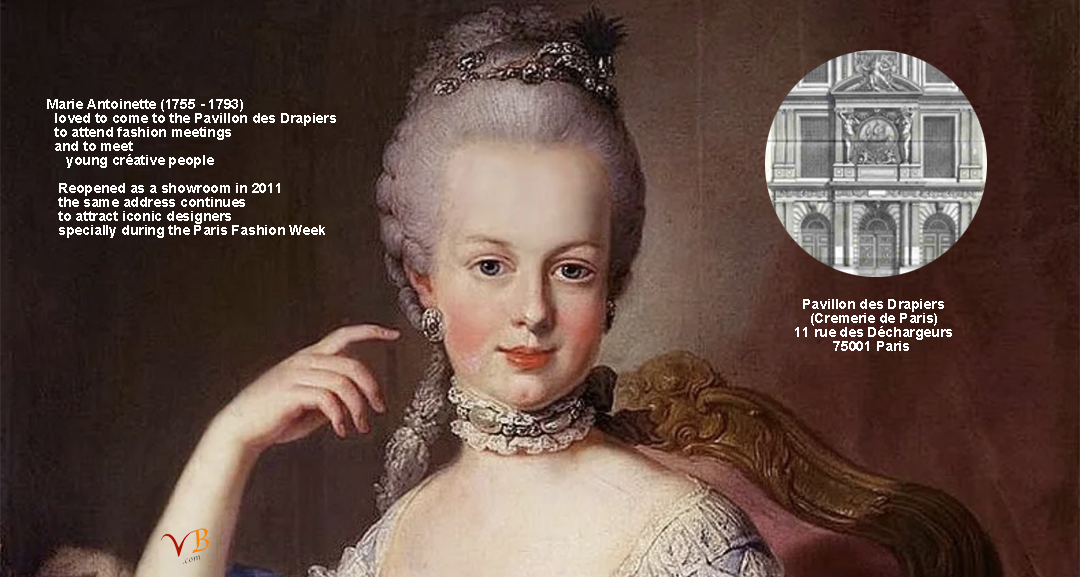
Marie Antoinette (1755 - 1793),
wife of Louis XVI,
5th Bourbon King,
3x great grandson of Louis XIV
reguarly came to the Pavillon des Drapiers
She was passionate about fashion reunions.
It was at rue des Déchargeurs
she discovered many talents.
.
End of a story
The buidling disappears
The facade is conserved
The Drapiers' Guild
and all other guilds
were abolished in 1791 with the French Revolution.
The Drapiers' Pavilion
became
the Grand Bureau de Bonneterie,
a knitwear store.
The Pavilion deteriorated,
and the caryatids on the facade
were damaged
and disappeared.
.

1858, a new project for the Les Halles district
took shape in Biarritz:
the Marché des Halles Centrales using pavilions
made entirely of iron and glass
designed by Victor Baltard (1805-1874).
There was also a new street, Rue des Halles,
which would become a connecting axis
between the Baltard Pavilions and Place du Châtelet, Rue de Rivoli.
The "artistic director"
was Empress Eugénie (1826-1920).
Much to the Empress's regret,
the Drapiers' Pavilion had to give way
to the new Rue des Halles.
She arranged for the façade to be preserved
and transferred to the Carnevalet Museum.
The sculptor Charles Gautier (1831-1891)
helped rebuild the damaged caryatids of the Pavilion.
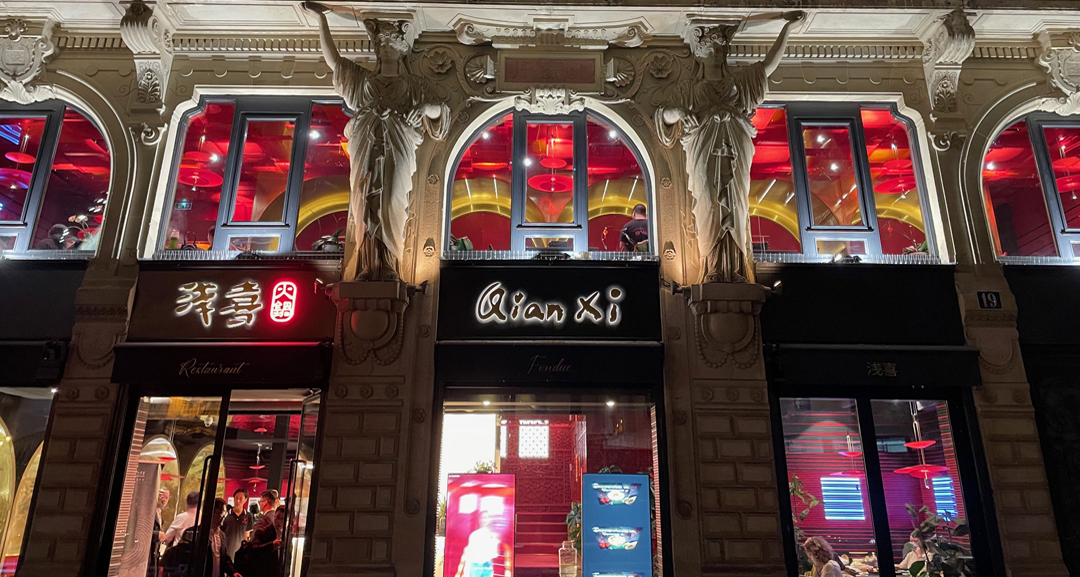
Charles Gautier was also the sculptor
of the caryatids at 19 Rue des Halles,
today home of Quianxi.
The restaurant located between
showomm N°1 and N°9
is a beautiful place for business lunches of diners.
Eugénie had the street's axis changed
to preserve the Hôtel de Villeroy Bourbon
(the left side of Showroom Paris is part of the Hôtel VB).
Return of a Story
Empress Eugénie

1869 Rue des Halles is completed,
the Pavillons Baltard are in place
at
11 Rue des Déchargeurs facing
the Les Halles foodmarket,
Cremerie de Paris, is established.
.
1870 The Prussians,
wishing to annex Alsace and Lorraine,
provoked a war,
which triggered the fall of the Second Empire
September 7.
The creative spirit of the new Les Halles district,
Empress Eugénie
left France
and went into exile in England,
where her friend Queen Victoria welcomed her.
Living for a very long time,
Eugenie was passionate about telling stories
about her Parisian market to children.

Her legends were passed down
from one generation to another
and would one day,
more than a century later,
lead to the return of the Cremeries de Paris,
which had all closed,
but which retained some of the magic
of the old Les Halles market.
.
Cremerie de Paris
and it's visitors
Louis II of Bavaria
and Sissi
The aura of the history of the Pavillon des Drapiers,
which became the Cremerie de Paris,
and the legends surrounding the childhood of Louis XIV
continue to attract legendary figures.
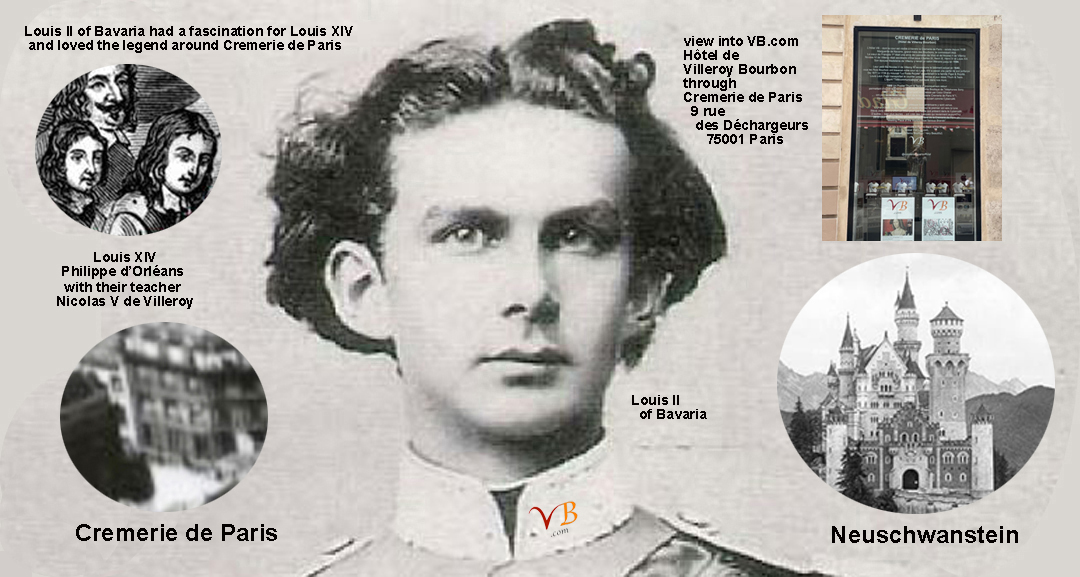
The photo shows the young King Ludwig II of Bavaria (1845-1886)
who visited the Cremerie de Paris twice.
Ludwig II of Bavaria had an admiration for Louis XIV
which is reflected in the construction of Heerenchiemsee
in the spirit of a small Versailles.
Louis II wanted to see Cremerie de Paris
as a place connected to the childhood of Louis XIV.
Ludwig II also built the castles of Neuschwanstein et Linderhof
and less known Koenigshaus am Schachen.
These buildings earned him the nickname
"Märchenkönig" / "King of Fairy Tales."
Cremerie de Paris beeing associated with many fairy tales
interested
Louis II.
He also loved
the magnificent Halles Centrales market,
which unfortunately disappeared on a decison of Marcel Diebold (1912-2002),
a prefect, who did not leave a good souvenir.
.
1864 Louis 2 became King of Bavaria at age 18.
Louis 2 was fascinated by French culture and
spoke French fluently. He admired all the Louis,
Bourbon Kings of France
and thus knew about Cremerie de Paris / Pavillon des Drapiers / VB.
Since childhood he wanted to travel to Paris.
- 1867 July
At age 22 this dream become reality.
His grandfather
the former King Louis I of Bavaria (1786-1868),
accompanied him.
Ludwig II came at the occasion of the World's Fair
organized by France during the Second Empire.
Napoleon III (1808 - 1873) hoped that Bavaria would abandon its alliance with Prussia and become closer to France.
Napoloén III gave Ludwig II and his grandfather
the best possible treatment.
According to Johannes Thurn & Taxis
(who later owned Eugenies tiara)
Empress Eugenie accompanied Louis 2
to Cremerie de Paris
facing her beloved Les Halles foodmarket.
She also showed him the Opera Garnier whih was still under construction
The 1867 trip to Paris with many people met at the Exposition Universelle
followed by a visit of the chateau de Versailles
and the Chateau de Pierrefonds near Compiegne
inspired Louis 2 for his soon to come construction
of the Neuschwanstein castle.
Next to Cremerie de Paris at the corner of
1 rue des Dechargeurs and 122 rue de Rivoli
was once located a magical
solar frame
designed by
Theodore Charles Gruyere,
Louis 2 estimated the sculptures of the artist.
Did you know that the first name "Louis"
in German "Ludwig"
of the Kings Ludwig von Bayern
goes back to Louis XIV.
There is even a direct link that crosses generations.
The third great-grandson of Louis XIV (3rd Bourbon King),
Louis XVI (5th Bourbon King)
was the godfather of Ludwig I, King of Bavaria.
The grandsons of Louis I ov Bavaria
were Louis II (1845 - 1886)
and his cousin Louis III (1845 - 1921),
the last King of Bavaria.
Louis II had a strong admiration
for Louis XIV, the "Sun King".
in his poems he considered himself
as the "Moon King".
The tradition to call the children of the family
"Louis / Ludwig" continues.
From time to time some young Wittelsbach
come to Paris
and they come by Cremerie de Paris
to see what is going on
.
They have the age Louis XIV had
when he came to the Hôtel de Villeroy Bourbon,
the right side of the showroom
is part of VB.
They are still too young to be interested
by the fashion brands that have come by,
they favorite expos are
the Pokemon, Fanta and Coca Cola.
One of the children is called "Louis".
For his last visit january 2025
we explained him
all the different "Louis" between
Louis XIV and himself.
.

1874 August
Louis II of Bavaria returned.
In the meantime the political landscape had changed dramatically.
France had become the 3rd Republic,
the Second Empire has gone, Napoleon III had died,
Bavaria had been forced into a coalition with Prussia.
Not much details are know about the second visit.
All we know from one of todays members of his family
is that Louis 2
presented his excuses
for the bad behavior of the Prussians.
.
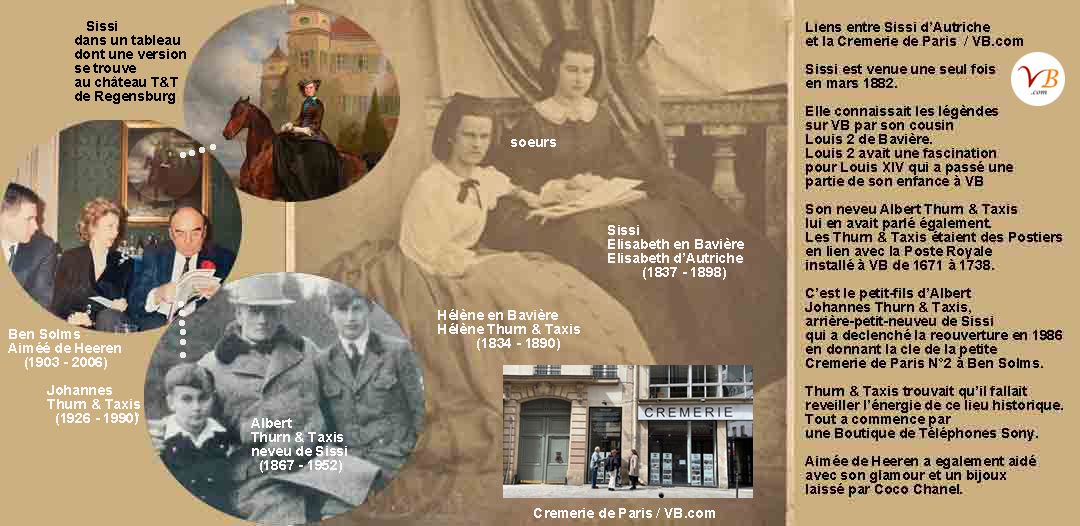
- Louis II's cousin,
Sissi in Bavaria / Sissi of Austria (1837 - 1898)
came in March 1882
She went to see her younger sister Sophie Charlotte (1847 - 1897)
who had once been the finacé of King Louis II.
Later Sophie Charlotte married
Ferdinand d'Orleans, duke of Alencon,
grandson of King Louis Philippe of France.
Johannes Thurn & Taxis (1926-1990),
the great-grandson of Sissi's older sister
Helène in Bavaria / Hélène Thurn & Taxis
recounted that Sissi had taken a train
from the Gare du Nord to Chantilly
and returned
to Paris earlier than expected
as she she wanted enough time
to visit Cremerie de Paris
and les Halles.
Thurn & Taxis played a key role
in the reopening of the Cremeries de Paris,
which began with the small Cremerie de Paris No. 2,
located 50 meters away.
It was also thanks to him that we were able to meet
Aimée de Heeren
who first appeared in this story in 1938,
56 after the visit of Empress Sissi
.
Johannes Thurn und Taxis called his second child Elisabeth
in reference to his great gran aunt Empress Elisabeth of Austria.

Johannes Thurn & Taxis also had an aount.
The only sister of his father
Elisabeth Helene Thurn und Taxis
(1903 - 1976)
was named after Empress Elisabeth / Sissi
and her older sister Hélène
(grandmother of Elisabeth Helene).

One of th grandsons of Elisabeth Helene Thurn & Taxis,
Memo von Sachsen
comes to the showroom every thime he is in Paris.
Memo von Sachsen Gessaphe is an adviser of some major modern art collectors
and helps them to find new contributions.
Thanks to Memo showroom Paris
has learned a lot about his own history.
Picture taken early 2025 din the restaurant Gladines (N°3)
facinf the showroom N°1
Another grandson of Elisabeth Hélène,
Alexander von Sachsen
is married to a great granddaughter of Sissi.
.
Vincent van Gogh
and many other impressionist
post-impressionists
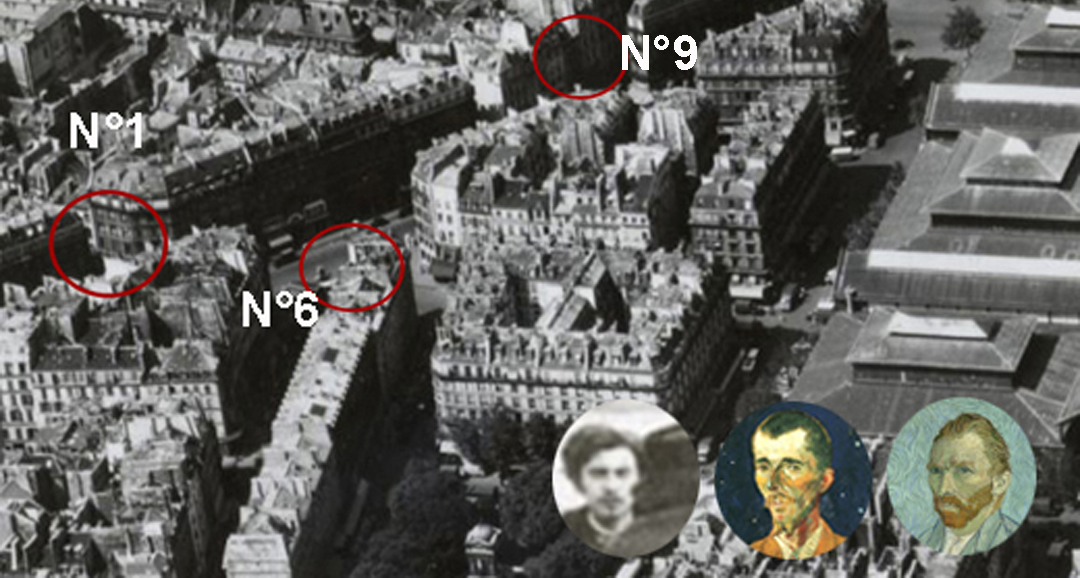
Vincent van Gogh (1853 - 1890)
knew the place by his friend Eugène Boch (1855 - 1941)
Eugène Boch was at the same time a post impressioniste
and an avant-garde modern art collector.
He had the chance to have inherited important revenues
he used to buy the paintings of his friends.
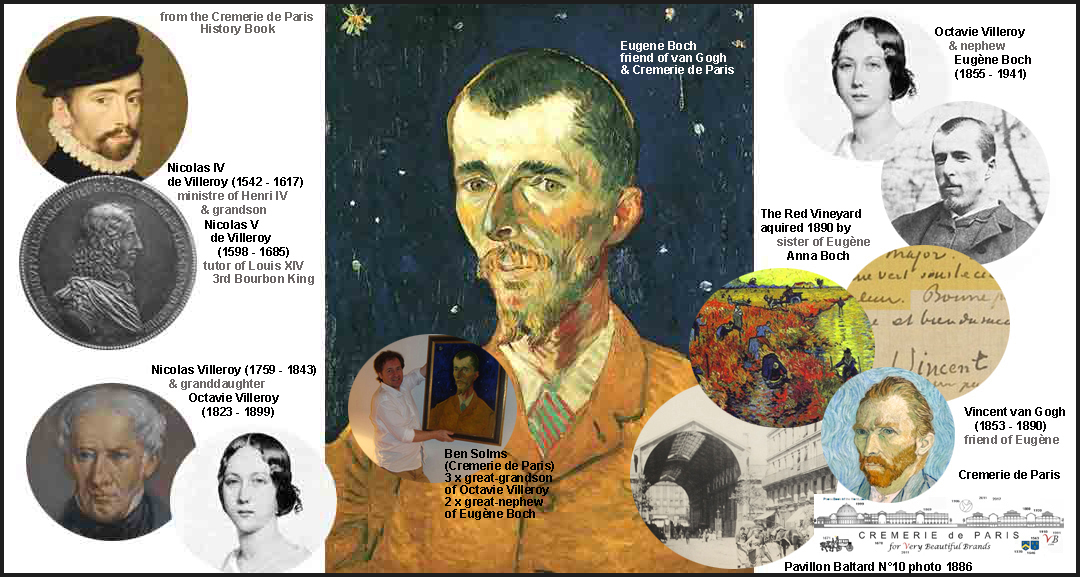
Eugène Boch was captivated
by the history of the old Villeroy Bourbon / VB mansion
(left side of the showroom).
He knew about the place from his aount Octavie Villeroy (1823 - 1899).
Octavie was the granddaughter Nicolas Villeroy
(1753 - 1843)
named after the illustrious Nicolas V de Villeroy (1598 - 1685),
teacher of Louis XIV.
Eugène Boch brought many artisits to Cremerie de Paris
and the VB mansion
Emile Bernard (1868 - 1941),
Henri Toulouse Lautrec (1864 - 1901),
Dodge Mac Knight (1860 - 1950),
Paul Cezanne (1839 - 1906),
Paul Gaugin (1848 - 1903)
At that time Cremerie de Paris
was no longer a place dedicated to fashion
but a milk and cheese store s
of the Les Halles foodmarket.
Emile Bernard did not live very far from the Showroom,
15 quai de Bourbon on Ile Saint Louis.
Too bad we can not talk to him
because he would know so much more
about Cremerie de Paris history
from the times of the food market.
Sometime we go to Ile Saint Louis
for an ice cream break in between two meeting
at the showroom.
The legends around
VB and
Cremerie de Paris / Pavillon des Drapiers
continue in Russia

Empress Eugénie that lived in the United Kingdom in exile came by Cremerie de Paris
every time she returned to Paris.
Eugènie had lost her only child,
Louis Napoléon (1856 - 1879)
and she loved to talk to children
telling them stories about the
young Louis XIV
growing up in between the Palais Royal
and the Hotel de Villeroy Bourbon.
She also loved to talk of the beautiful Halles Centrales
she had imagined
with her architect Victor Baltard (1805 - 1874).
Her favorite young friend was a granddaughter
of Queen Victoria (1819 - 1901).
The girl had lost her own mother,
the oldest daughter of Queen Victoria
and lived between Darmstadt and London,
Alix Hessen (1872 - 1918)
.
1894 November 26 Alix marriered
Nicolas II of Russia (1868 - 1918).
The legends about Cremerie de Paris "travelled" to Russia
and continued in Saint Petersbourg
The young Romanov children
and from time to time their cousins loved them.
Through some of the cousins, Dmitri and Carl
they returned to Paris.
.
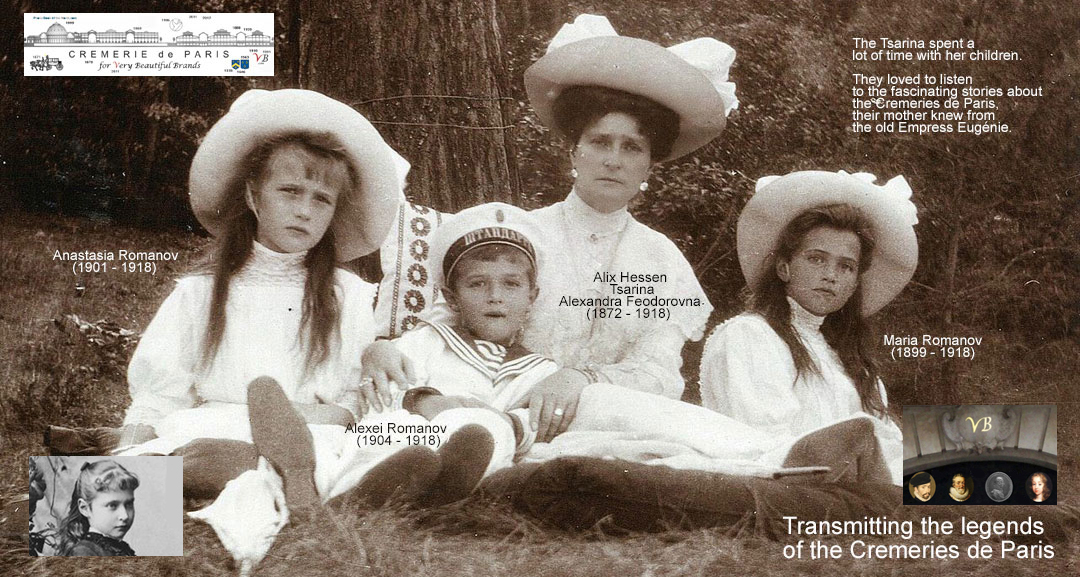
The Romanov loved the stories
about Cremerie de Paris,
the Pavillon des Drapiers, the child Louis XIV
like other children like the stories about Santa Claus.
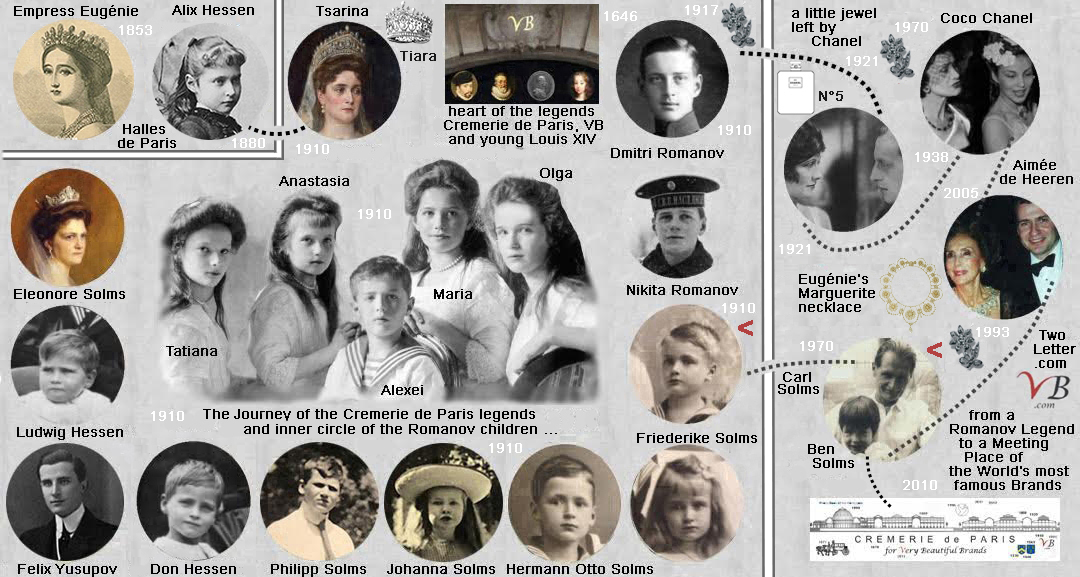
This picture shows the the interior cercle around the
Romanov children.
All the children dreamed about travelling to Paris
to discover les Halles and VB.
VB is the acronym for
"Villeroy Bourbon".
Anastasia Romanov (1901 - 1918)
renamed VB as "Very Beautiful".
Dmitri Romanov (1891 - 1942)
was the oldes of the children.
Alexei Romanov (1904 - 1918)
the youngest.
His friend and same age cousin was Carl Solms (1903 - 2004).
.
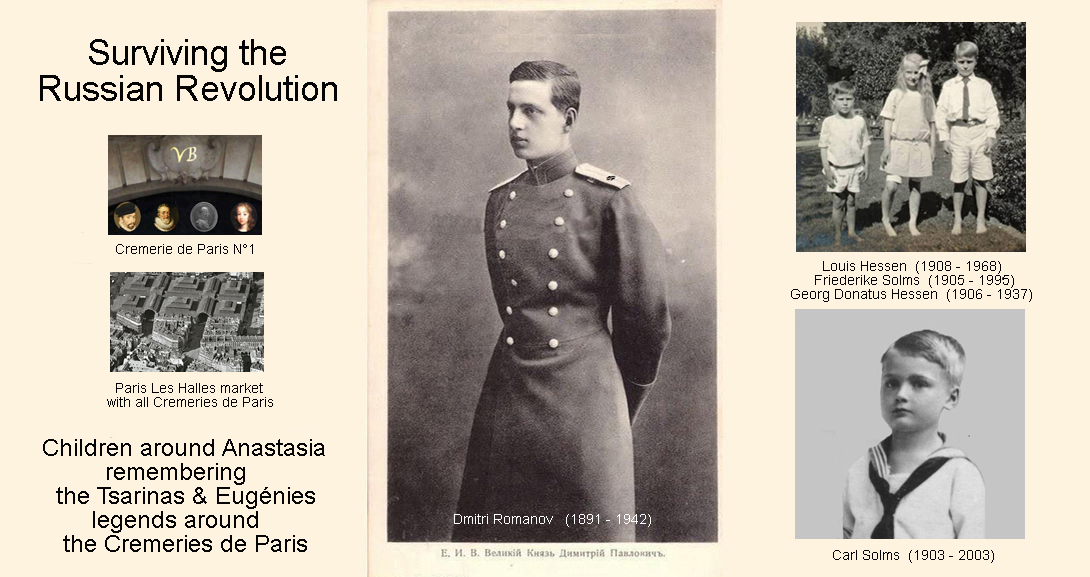
Dmitri Romanov and Carl Solms
survived the Russian Revolution.
1921 Dmitri would become the boyfriend
of
Gabrielle Chanel.
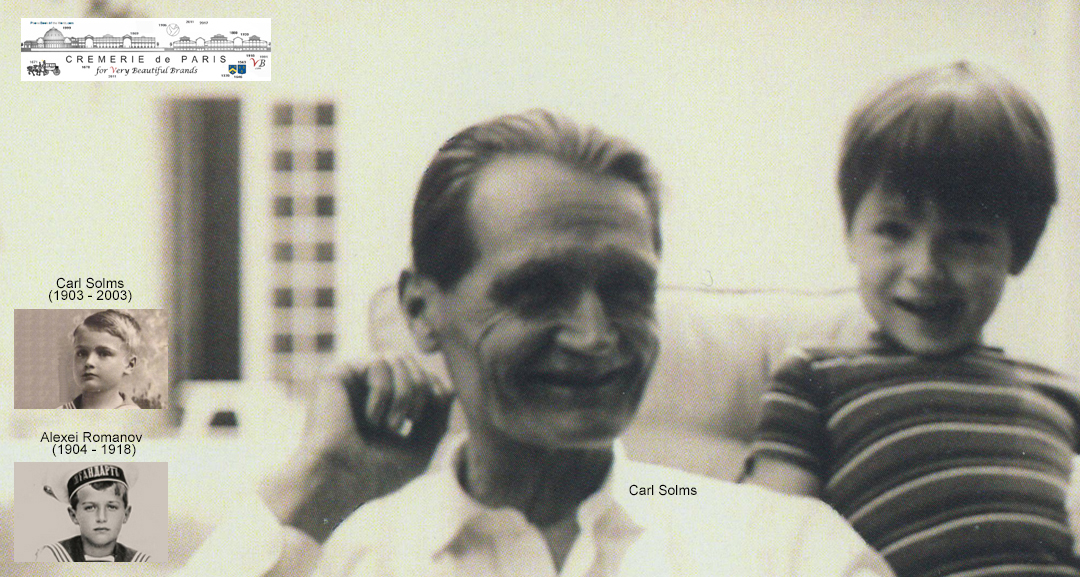
Half a century later
Carl Solms would become the babysitter
of a child to whom he transmitted a love for Paris
resulting in the idea
to
the have the magic of the past of VB,
fallen asleep after the end
of the Les Halles foodmarket,
return.
.
Coco Chanel
Dmitri Romanov
and Aimée de Heeren
key people in the story
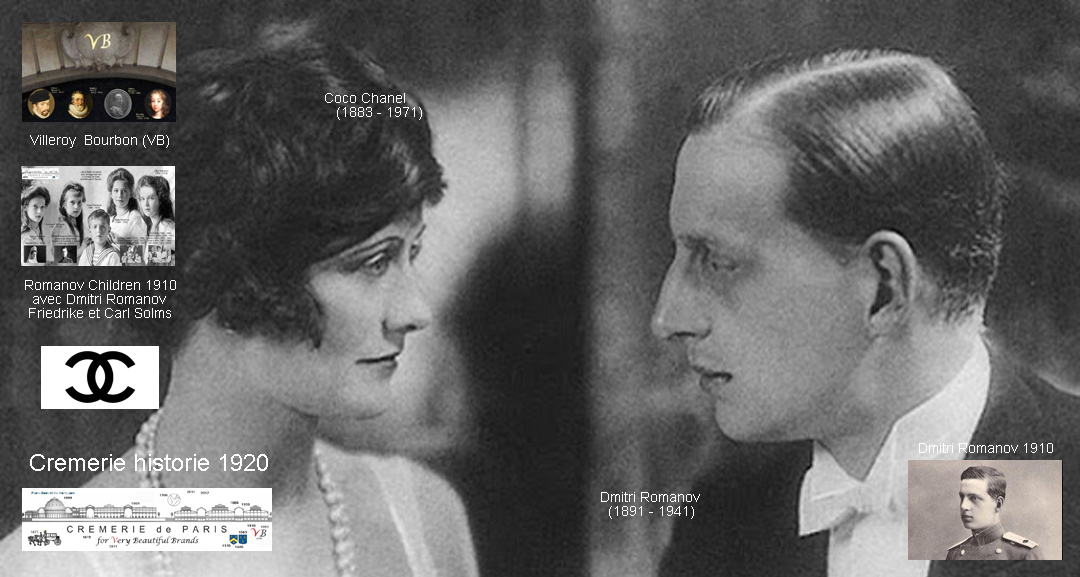
Coco Chanel discovered the Showroom / Cremerie de Paris thanks to Dmitri Romanov.
Dmitri was lucky to be in Iran the
moment the revolution broke out.
Thus he was able to come to Paris
where he lived in a modest place in Boulogne sur
Seine.
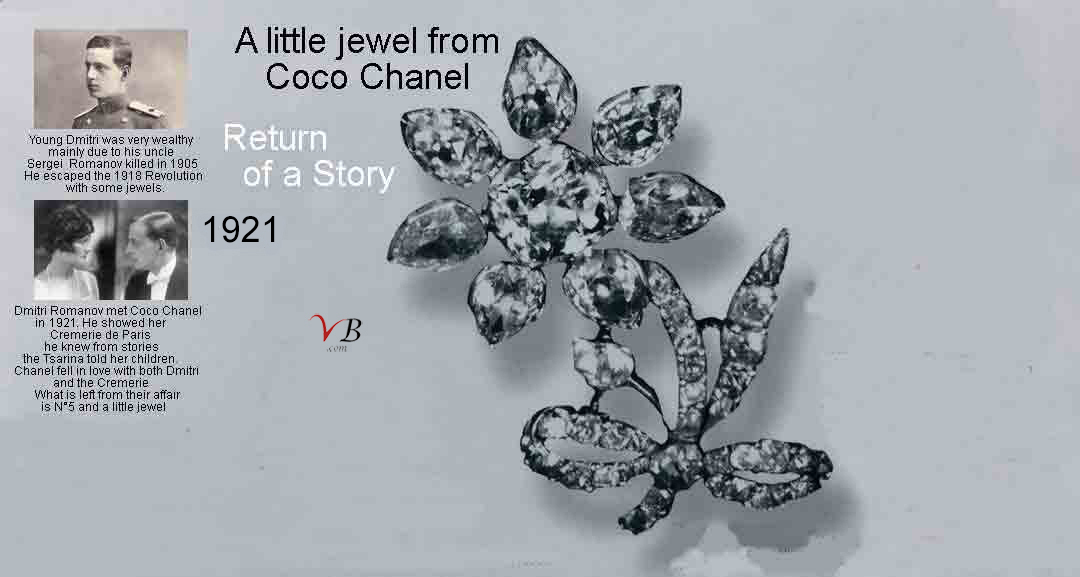
All that was left to him from the Romanov fortunes
were a few jewels.
One of them, a beautiful small broach
became a present for a magical woman
that turned into his girlfriend,
Coco Chanel.
Chanel invited him to live with her
at her Villa Bel Respiro in Garches.
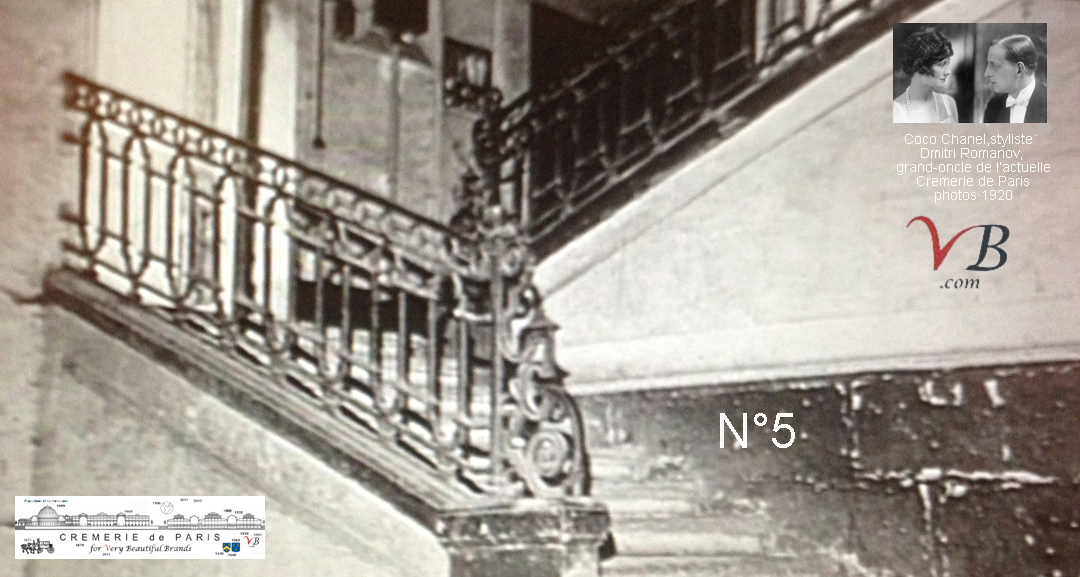
In the VB couryard, behind the Showroom Paris N°1
is a magical staircase with a "number 5"
logo forged into the railings.
Le "5" on the staircase captivated Gabrielle Chanel
as it is her lucky number.
According to Aimee de Heeren
the staircase and the magic of VB
had an impact on the idea to create the Perfume N°5.
Did you know that Dmitri designed the first bootle
and that it was his idea to create the CC monogram logo ?
In the Romanov family everybody had a monogram
so the idea came up to design "CC"
visible the first time on the Chanel N°5 perfume bottle.
Unfortunately the Love Storey
between
Gabrielle Chanel and Dmitri Romanov
did not last,
but what id left is "CC",
"N°5"
and
a little jewel.
.
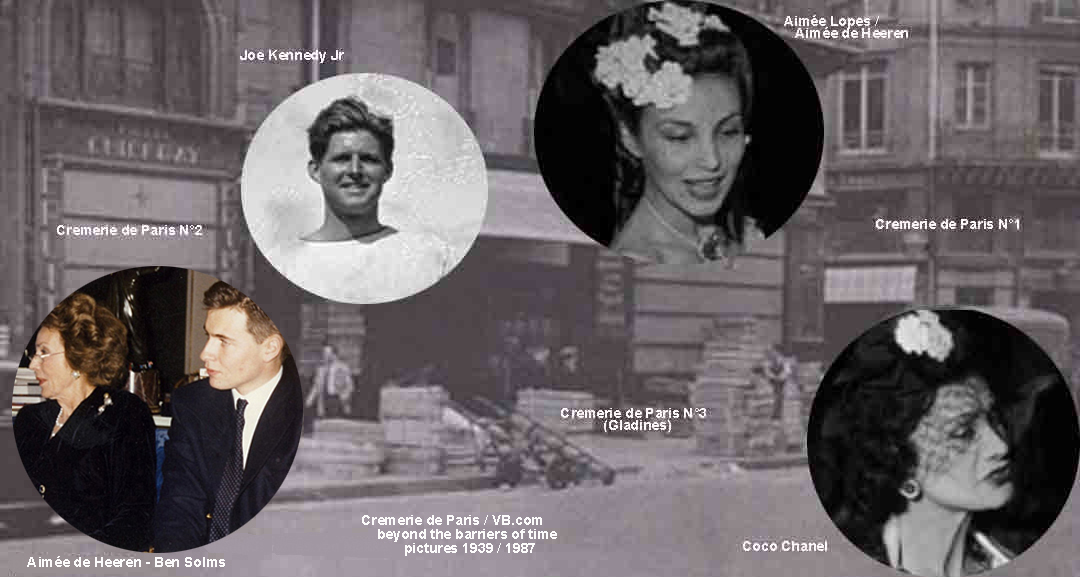
1938 Chanel meets a young Brazilian woman,
Gabrielle Chanel and the Paris Hi Society
are captivated by the beauty of Aimee Sotto Major,
a fashionista who spends her time trying on dresses an
d going out to parties.
According to the ememoirs of Vogue editor
Bettina Ballard
"Aimée was so beautiful, so charming,
she radiated the joy of living like a fan,
you almost wanted to eat her alive.
Decked in diamonds,
she went from a dress fitting to a gala evening,
never having time for a private conquest
because every hostess needed her for her party
to prove she was capable of bringing
the icon of the season to her reception."
Chanel tshowed her the magic of Cremerie de Paris
once the Pavillon des Drapiers.
No other place was connected
to that much fashion history.
Gabrielle Chanel et Aimée Sotto Major
could often be seen together
at receptions like
the two Circus Balls given in Versailles by Lady Mendl.
Pre-war Paris was astonished that such a young,
extraordinarily beautiful woman
could have so much money without a husband.
While people imagined
that the young woman
was the daughter of an ultra wealthy Brazilian,
the reality was quite different.
Genesio de Sotto Mayor
was a teacher in a small school in Castro
in the Brazilian State of Parana.
But who would have
paid for the amazing lifestyle of the young woman ?
Secret Service agent and
resistant
a Kennedy Love Story
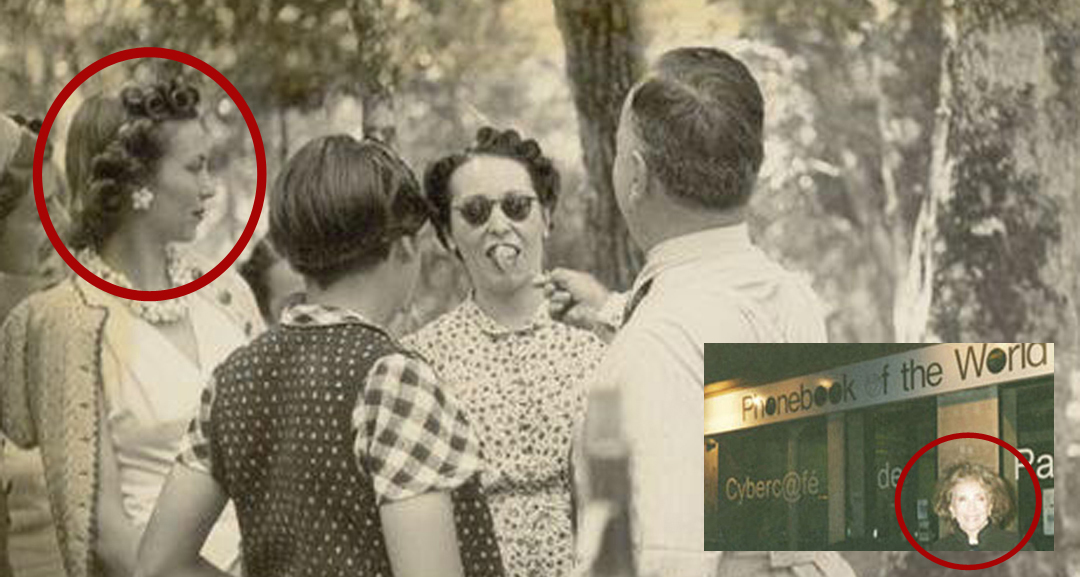
1938 World War II was approaching
and Brazil was asked to join the Axis Alliance
formed
between Germany, Italy, and Japan.
Aimées reason reason to come to Paris
was not to shop clothes,
but to work as a Secret Service Agent.
Her mission was to find information
so that President Vargas would
be guided which alliance to choose.
The picture shows Aimée Sotto Major / Aimée de Heeren in 1937
with her employer President Getulio Vargas (1882 - 1954)
and the first Lady Darci Vargas
(1895 - 1968)
The small image shows the same Aimée de Heeren
68 years later in 2005
while visiting the showroom
during it's web cafe years
to take internet lessons.
Under the cover of a pure fashionista
Aimée managed to get acces to lots of secret informations.
The key person was Helmut James von Moltke
a lawyer from Berlin.
he gave her ultra confidential documents
showing the real project of the Nazi regime.
The documents has a strong impact on Aimée.
From an Agent that was collecting information
she turned into a resistant
that took the decision to do all what was in her possibilities
to fight the Nazis.
She used her influence on Président Vargas
to get him away from the idea to sign the Axis alliance.
But Aimé realised that only the economic power of the United States
would be capable to change Europe's destiny.
She needed to find a way to connect with President Roosevelt
who wanted America to stay out of the conflict in Europe.
What could she do ?
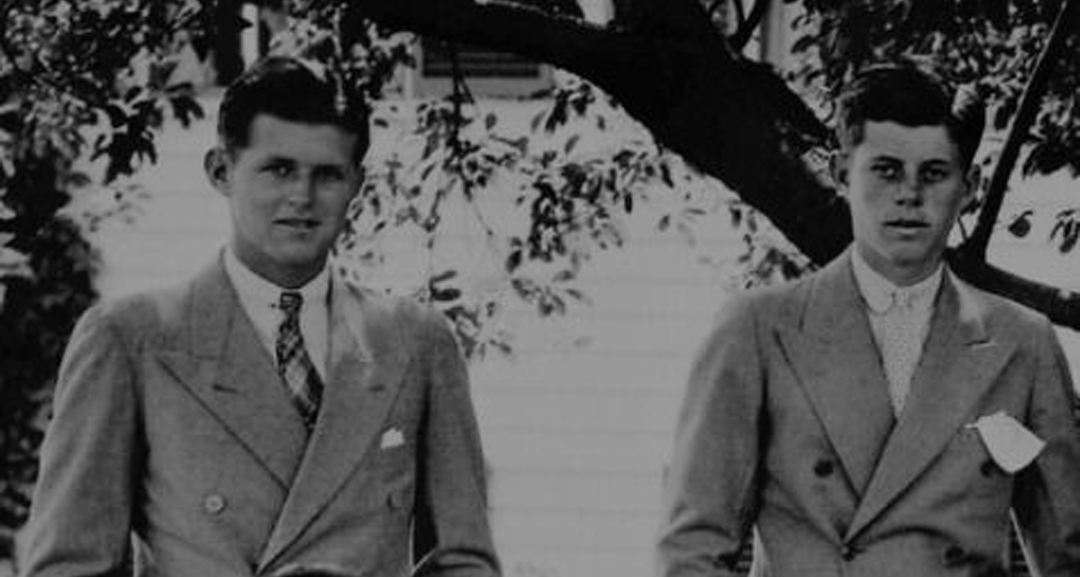
At a London reception she run into two young brothers.
They were the sons of the US Ambassador.
Joe Kennedy Jr (1915 - 1944)
and John Fitzgerald Kennedy (1917 - 1963).
The boys were both dazzled by her beauty.
.
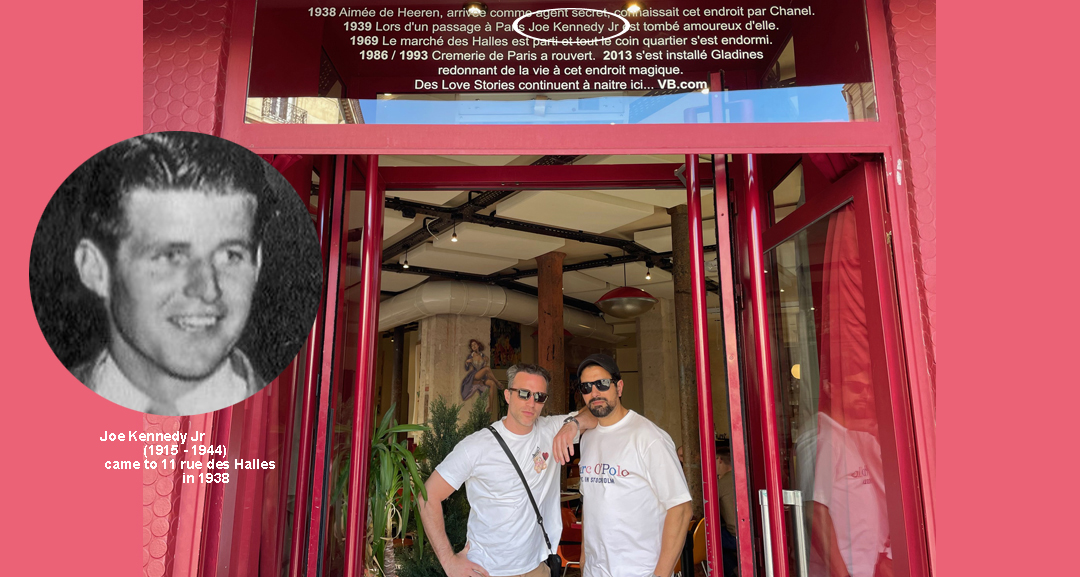
1939 February Joe Kennedy Jr came to see her in Paris.
Aimée showed him Cremerie de Paris
and the Cedre Impérial de Meudon.
Something that should never happen to a Secret Service Agent
happened,
she fell in Love.
Their encounter is mentioned in the historic inscriptions
of the facade of 11 rue des Halles,
Restaurant Gladines
that faces the Showroom N°1
1939 November
A telephone conversation between Aimée
and President Vargas
was intercepted
by a German Rio de Janeiro based spy.
The fashionista's life was in danger.
She had to instantly disappear from Paris.
After
hiding in Meudon outside Paris
Robert de Billy (1869 - 1953) drover her to le Havre
where she took the ferry
boat to New York
as "Madame Lopez".
Francoise Cochin (1923 - 2013) remebered this episode
related to the showroom a few years Aimee had already left this world.
This Video about Aimee de Heeren
came out in Mai 2025,
more or less the same moment this article was written
There are some small errors at the end
but
the young Youtuber Stephanie Morganti from Brazil
reflects Aimées glamour,
a glamour linked to the history of Showroom Paris.com
.
To answer your question Stephanie,
Aimée received documents from Helmuth James von Moltke
that had turned her into
a "resistant"
.
Two decades later
Chanel returns to Paris
Aftre leaving Paris without notice
Chanel had to wait 20 years before seeing Aimée again.
The war is over, a friendship is reborn.
Coco Chanel, after spending a long time in Lausanne,
returns to Paris in 1954.
The two women develop the habit of taking walks in the middle of the night.
Chanel suffered from insomnia
and Aimée often returned home late from a party.
From their hotels around Place Vendome,
The Ritz for Gabrielle Chanel and the Meurice for Aimée de Heeren
the two women walked along Rue Saint Honoré
towards the Les Halles market open during the entire night.
After a drink at Maison Rouge (N°7)
they walked around Cremerie de Paris N°1
and on the staircase behind the showroom
Chanel told her the stories around the invention du N°5
and they spoke about all the people they had both known
a long time ago.
.
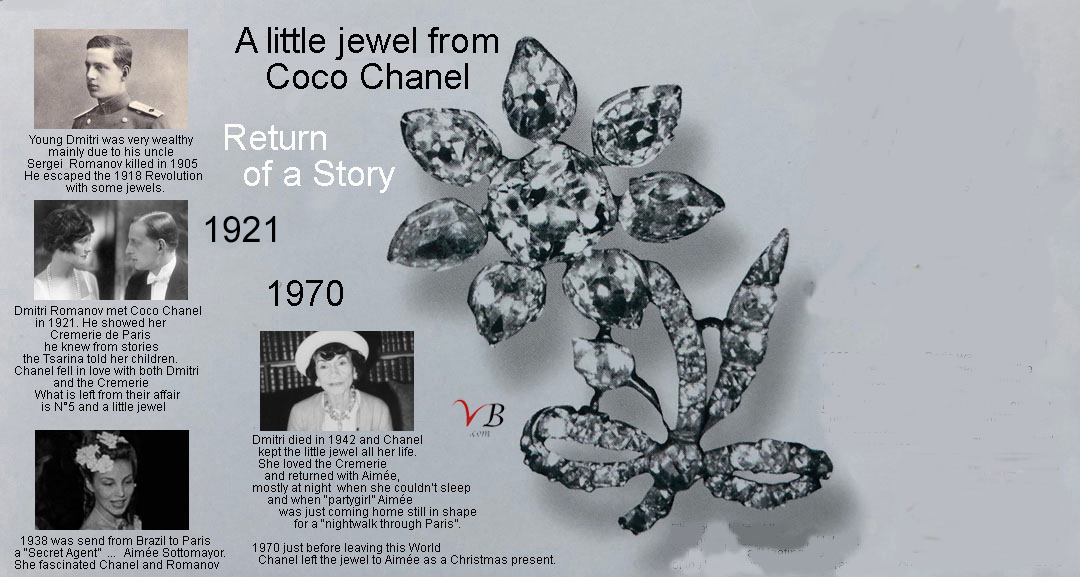
1970 just before Xmas their last walk.
Chanel takes a small pocket out of her coat
containing a "Christmas present"
that Aimée was supposed to keep
as a luck bringer,
the little jewel
Aimée left Paris the next morning,
20 jours later
1971 January 10
Chanel left this world.
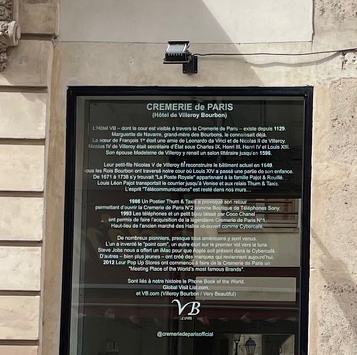
A bay window offers a view of the historic courtyard
of the Hôtel de Villeroy Bourbon
from 9 Rue des Déchargeurs
right
through the showroom.
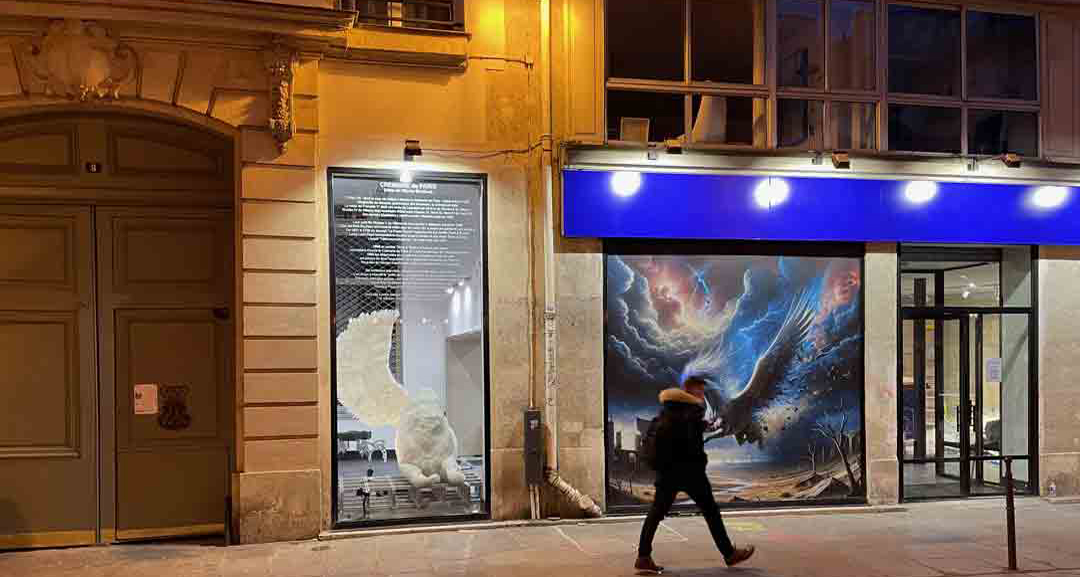
Some Showroom clients like Adererror
keep the historic inscriptions
in the facade of their showroom,
others don't
.
Again Two decades later
Chanel's friend Aimée
meeting a young student
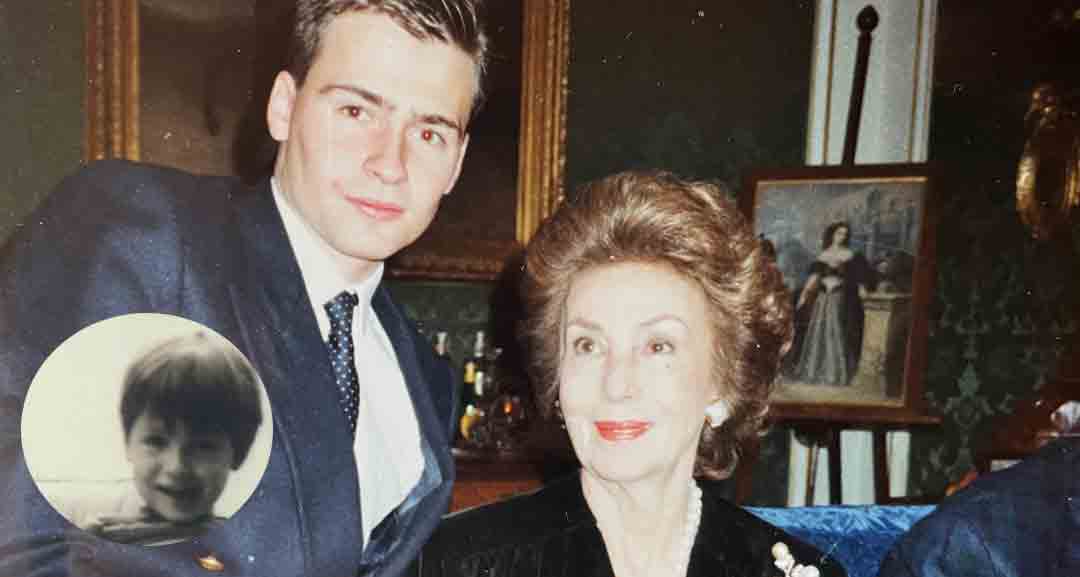
Years go by ....
The young man in the picture,
alread in the long history as a child 15 years earlier
still has in mind
to get Cremerie de Paris back to life.
But how to do this ?
Unfortunately from the Romanov fortunes
nothing was left for him
no shares, no objects
only
a touch of glamour,
The glamour was called Aimée de Heeren.
Aimée still liked to walk through Paris
in the middle of the night.
She was missing Chanel's company.
Whom could she ask to be a new company
for her Paris night walks ?
One day Aimée meets a young student.
The student had just turned 20.
He was amused by the idea.
Aimée was so beautiful
that most people met on the road turned and looked back.
But at that time, he didn't realize
that he was with someone much much older than he beleived
who was taking him across time.
He also didn't realize that his company was
one of the most influential secret agents of World War II.
.
1993 Cremerie de Paris N°1
the place on the grounds
of the Pavillon des Drapiers
was for sale.
The small Cremerie de Paris N°2
had already reopened
as a sucessfull Sony phone store.
But impossible to get a real estate loan.
In France it is very difficult
to get financing for people
when they are very young.
Finally Deutsche Bank from Saarbruecken
located only 5 km from the French border
liked the project,
but they were asking for
a down payment that was exceeding
the possibilities of the small Phone Boutique
....
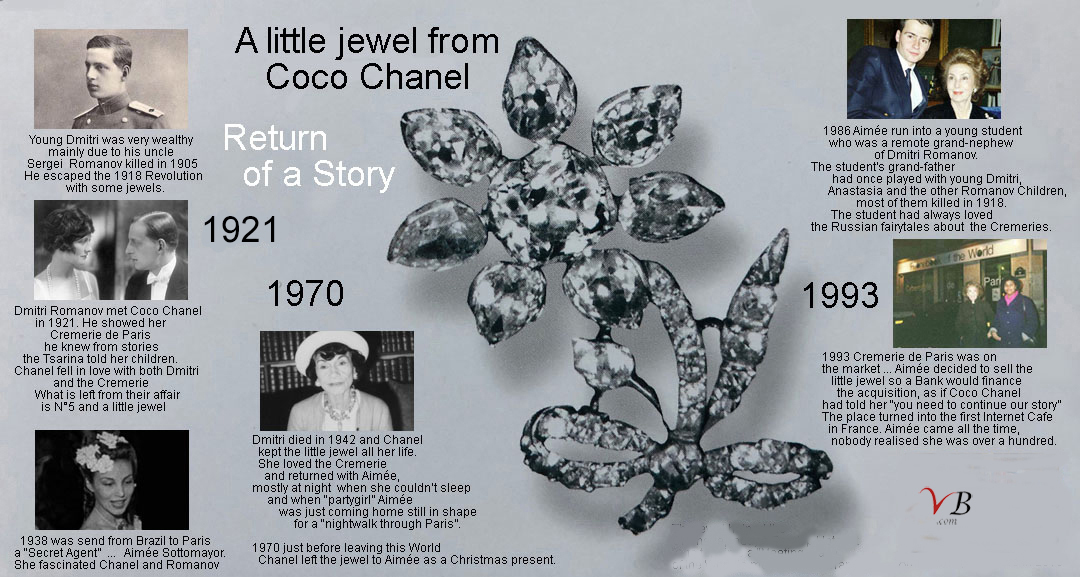
Aimée was fascinated by the idea.
This place with so many fashion stories
including the ones of her beloved friend Gabrielle Chanel ...
She took the little jewel Chanel
had left her and decided to sell it
to help increase the bank deposit.
Thanks to the money from Coco Chanel's jewel
Deutsche Bank / DB.com
accepted to finance the project.
Cremerie de Paris N°1 reopended
as if Chanel that had already left this world
two decades before
had decided to continue the story ...
Avant-garde Internet Cafe
VB.com
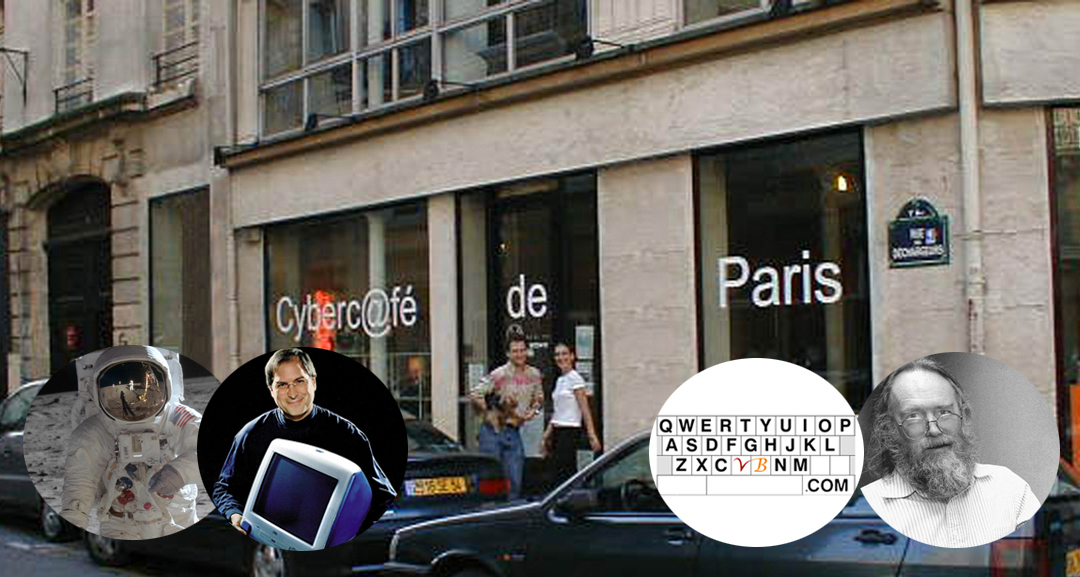
1993 Reopening of the former Pavillon des Drapier
not yet as "Showroom Paris"
but as something completely new at the time,
the first Internet Cafe in France
called "Cybercafe de Paris".
The Cybercafe was so much avant-garde
electricity got turned off all the time.
The only clients were a few American tourists
desperately looking for a web connection
in the French capital.
Among them people you don't meet every day.
One had been on the first flight to the moon,
another one was the inventor of "dot com".
Steve Jobs not happy the cafe only used Sony computers
offered us an iMac
as if he had wanted Apple
to have a little spot in this long fashion
story.
The situation changes in 1999
more and more people arrived at the webcafe (showroom)
but in 2005 internet starts to be everywhere.
The cafe closes and the place is rented
as a showroom
for household equipments.
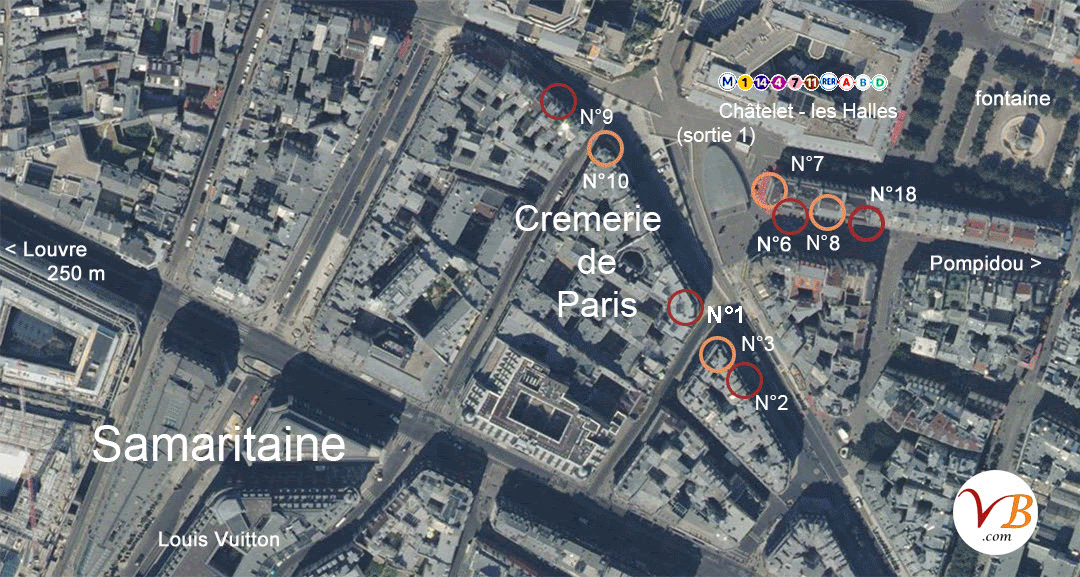
Are left from the Cybercafe years many beautiful souvenirs
and an exceptionnal collection
of ultra easy internet domains.
The web domains which include
the Two Letter domain
VB.com, Showroom Paris.com or Visit 75001.com
give a lot of visibility to brands
that want their products to be seen.
.
Again Two decades later
Fashion Showrooms
almost 20 years after the Cybercafe
arrives the first fashion showroom.
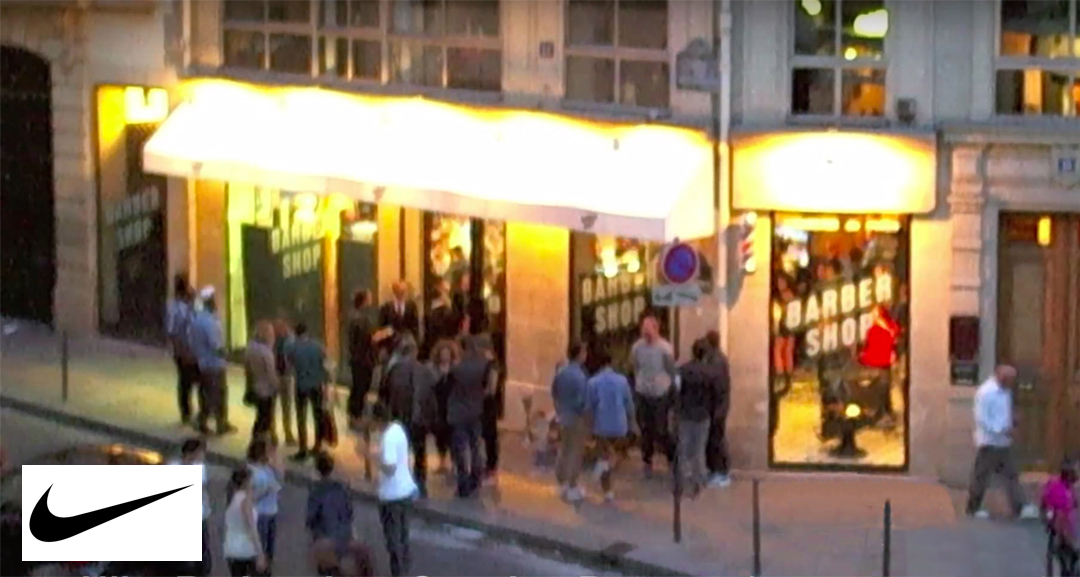
2012 Nike Barbershop is the first one
One of the visitors of the Cybercafe
helped to attract America's most famous fashion brand.
Nike wanted to in the place that had seen a man from the Moon walk through it's doors.
The Barbershop was part of a project
that took place in 7 cities around the globe.
Nike Barbershop organized by
Antoine Leca and Victoire Guillaumet

all what is left from the Pavillon des Drapiers
on rue des Dechargeurs is a geographic point
that has seen a unique fashion story
as nobody else.
The facade has been preserved
and transferred to the Musée Carnavalet.
More Showrooms and Pop Up Stores
add new glamour chapters
to a long story
3D Visit of Showroom Paris N°1 decorated as a Museum
A retrospective of the most beautiful Showrooms and Brand Expos are shown in the VB.com Museum,
so they continue to be admired
even when an event is over.
2013 Opening of our cafe Gladines (N°3)
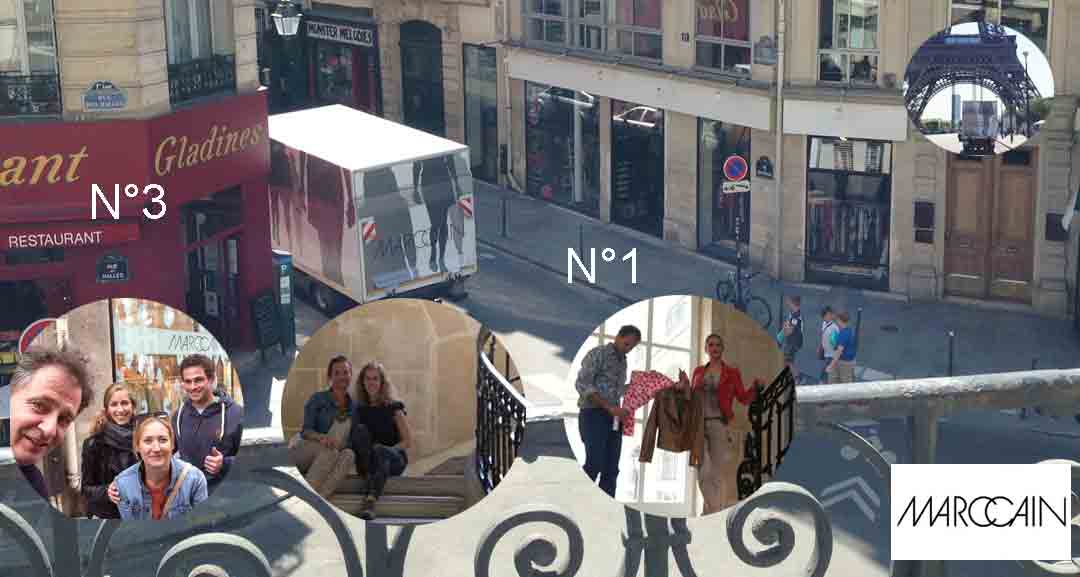
2014 to 2016 5 FW Showroom from Marc Cain
organized by Maria-Cora Eichenauer and Yann Le Meilleur
2016 Showroom Paris N°6
already part of our Sony network in the 1990s
the showroom came back. It is facing
Showroom N°1 on the other side of
place Marguerite de Navarre.
Also opening our Brasserie Masion Rouge (N°7 and N°8)
.
2717 in between our locations
opens the new subway exit Marguerite de Navarre
making it extremly easy to arrive at the Showrooms
from both Paris Aeroports
CDG and Orly are at a distance of 30 min).
.

2019 Showroom Paris N°9
a 120 + 57 m2 Showroom
located on rue Saint Honoré at a distance of 150 m
is completing the collection
Under Armour Showroom 2018
organized by Catherine North and Alex Delatour
.
FW Showroom 2020 January by Misbhv
organized by Patrycja Szklarczyk.
.
2023 Showroom Coca Cola
organized by Zyad Rouissi
with the singer
Rosalia Vila Tobela
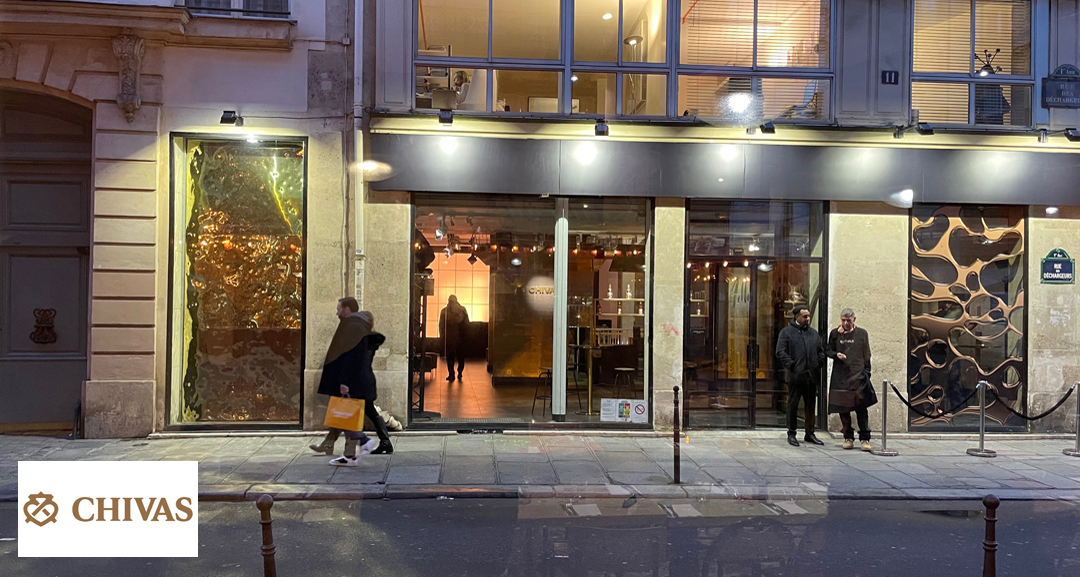
2023 Christmas Showroom de Noel by Chivas
designed by Victoire Guillaumet, Victor Daussy
and the jewellery artist Dolly Cohen
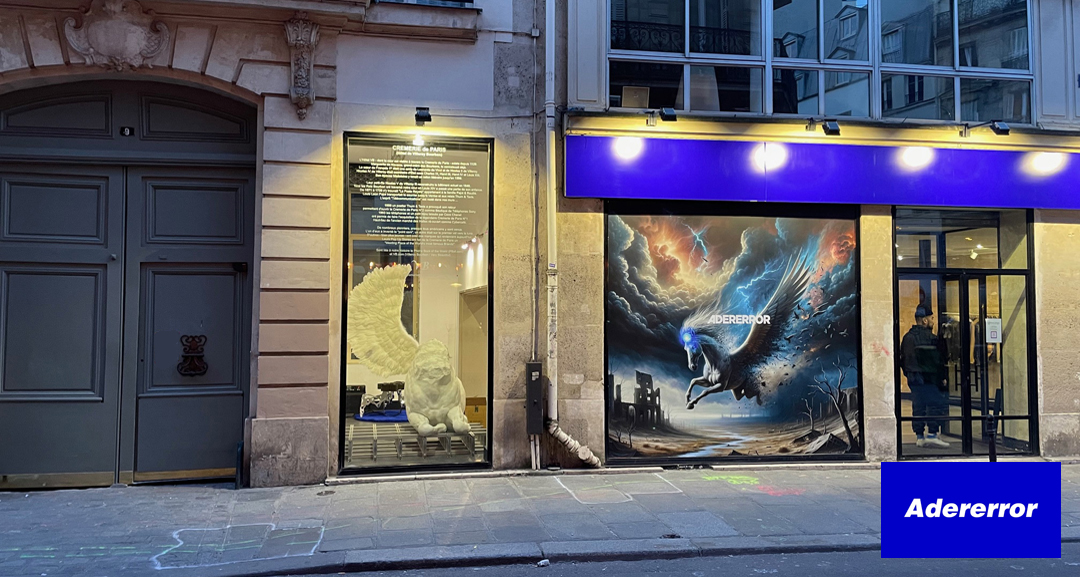
2024 January FW Showroom from Korea by Adererror
organized by Seyoung Kim with scuptures of Kiwon Lee
The Pop Up Store Museum
can be seen in between events taking place
at Showroom N°1.
The windows start to become a tourist attraction.

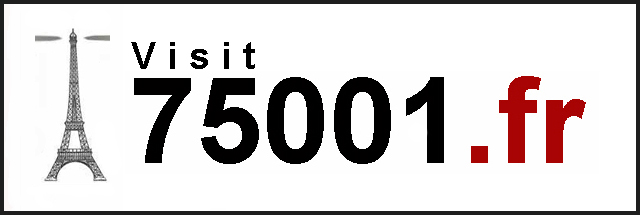
Who is next ?
